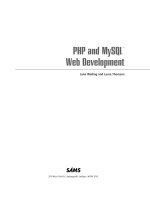PHP and MySQL Web Development - P50 ppsx
Bạn đang xem bản rút gọn của tài liệu. Xem và tải ngay bản đầy đủ của tài liệu tại đây (65.12 KB, 5 trang )
217
Updating Records in the Database
select customerid, avg(amount)
from orders
group by customerid
having avg(amount) > 50;
Note that the HAVING clause applies to the groups.This query will return the following
output:
+ + +
| customerid | avg(amount) |
+ + +
| 2 | 74.980003 |
+ + +
Choosing Which Rows to Return
One clause of the SELECT statement that can be particularly useful in Web applications is
the LIMIT clause.This is used to specify which rows from the output should be returned.
It takes two parameters: the row number from which to start and the number of rows to
return.
This query illustrates the use of LIMIT:
select name
from customers
limit 2, 3;
This query can be read as,“Select name from customers, and then return 3 rows, starting
from row 2 in the output.” Note that row numbers are zero indexed—that is, the first
row in the output is row number zero.
This is very useful for Web applications, such as when the customer is browsing
through products in a catalog, and we want to show 10 items on each page.
Updating Records in the Database
In addition to retrieving data from the database, we often want to change it. For exam-
ple, we might want to increase the prices of books in the database.We can do this using
an
UPDATE statement.
The usual form of an UPDATE statement is
UPDATE tablename
SET column1=expression1,column2=expression2,
[WHERE condition]
[LIMIT number]
The basic idea is to update the table called tablename, setting each of the columns
named to the appropriate expression.You can limit an UPDATE to particular rows with a
WHERE clause, and limit the total number of rows to affect with a LIMIT clause.
12 525x ch09 1/24/03 3:37 PM Page 217
218
Chapter 9 Working with Your MySQL Database
Let’s look at some examples.
If we want to increase all the book prices by 10%, we can use an UPDATE statement
without a WHERE clause:
update books
set price=price*1.1;
If, on the other hand, we want to change a single row—say, to update a customer’s
address—we can do it like this:
update customers
set address = '250 Olsens Road'
where customerid = 4;
Altering Tables After Creation
In addition to updating rows, you might want to alter the structure of the tables within
your database. For this purpose you can use the flexible
ALTER TABLE statement.The
basic form of this statement is
ALTER TABLE tablename alteration [, alteration ]
Note that in ANSI SQL you can make only one alteration per ALTER TABLE statement,
but MySQL allows you to make as many as you like. Each of the alteration clauses can
be used to change different aspects of the table.
The different types of alteration you can make with this statement are shown in
Table 9.4.
Table 9.4 Possible Changes with the ALTER TABLE Statement
Syntax Description
ADD [COLUMN] column_description Add a new column in the specified location
[FIRST | AFTER column ] (if not specified, then the column goes at the
end). Note that
column_descriptions need
a name and a type, just as in a
CREATE state-
ment.
ADD [COLUMN] (column_description, Add one or more new columns at the
column_description, ) end of the table.
ADD INDEX [index] (column, ) Add an index to the table on the specified col-
umn or columns.
ADD PRIMARY KEY (column, ) Make the specified column or columns the
primary key of the table.
ADD UNIQUE [index] (column, ) Add a unique index to the table on the speci-
fied column or columns.
ALTER [COLUMN] column {SET DEFAULT Add or remove a default value for a
value | DROP DEFAULT} particular column.
12 525x ch09 1/24/03 3:37 PM Page 218
219
Deleting Records from the Database
CHANGE [COLUMN] column new_column Change the column called column so that
_description it has the description listed. Note that this can
be used to change the name of a column
because a
column_description includes a
name.
MODIFY [COLUMN] column_description Similar to CHANGE. Can be used to change
column types, not names.
DROP [COLUMN] column Delete the named column.
DROP PRIMARY KEY Delete the primary index (but not the col-
umn).
DROP INDEX index Delete the named index.
RENAME [AS] new_table_name Rename a table.
Let’s look at a few of the more common uses of ALTER TABLE.
One thing that comes up frequently is the realization that you haven’t made a partic-
ular column “big enough” for the data it has to hold. For example, in our Customers
table, we have allowed names to be 30 characters long.After we start getting some data,
we might notice that some of the names are too long and are being truncated.We can
fix this by changing the data type of the column so that it is 45 characters long instead:
alter table customers
modify name char(45) not null;
Another common occurrence is the need to add a column. Imagine that a sales tax on
books is introduced locally, and that Book-O-Rama needs to add the amount of tax to
the total order, but keep track of it separately.We can add a tax column to the Orders
table as follows:
alter table orders
add tax float(6,2) after amount;
Getting rid of a column is another case that comes up frequently.We can delete the col-
umn we just added as follows:
alter table orders
drop tax;
Deleting Records from the Database
Deleting rows from the database is very simple.You can do this using the DELETE
statement, which generally looks like this:
Table 9.4 Continued
Syntax Description
12 525x ch09 1/24/03 3:37 PM Page 219
220
Chapter 9 Working with Your MySQL Database
DELETE FROM table
[WHERE condition] [LIMIT number]
If you write
DELETE FROM table;
on its own, all the rows in a table will be deleted, so be careful! Usually, you want to
delete specific rows, and you can specify the ones you want to delete with a WHERE
clause.You might do this, if, for example, a particular book were no longer available, or if
a particular customer hadn’t placed any orders for a long time, and you wanted to do
some housekeeping:
delete from customers
where customerid=5;
The LIMIT clause can be used to limit the maximum number of rows that are actually
deleted.
Dropping Tables
At times you may want to get rid of an entire table.You can do this with the DROP
TABLE statement.This is very simple, and it looks like this:
DROP TABLE table;
This will delete all the rows in the table and the table itself, so be careful using it.
Dropping a Whole Database
You can go even further and eliminate an entire database with the DROP DATABASE
statement, which looks like this:
DROP DATABASE database;
This will delete all the rows, all the tables, all the indexes, and the database itself, so it
goes without saying that you should be somewhat careful using this statement.
Further Reading
In this chapter, we have given an overview of the day-to-day SQL you will use when
interacting with a MySQL database. In the next two chapters, we will look at how to
connect MySQL and PHP so that you can access your database from the Web.We’ll also
explore some advanced MySQL techniques.
If you want to know more about SQL, you can always fall back on the ANSI SQL
standard for a little light reading. It’s available from:
/>12 525x ch09 1/24/03 3:37 PM Page 220
221
Next
For more detail on the MySQL extensions to ANSI SQL, you can look at the
MySQL Web site:
Next
In Chapter 10,“Accessing Your MySQL Database from the Web with PHP,” we’ll cover
how you can make the Book-O-Rama database available over the Web.
12 525x ch09 1/24/03 3:37 PM Page 221









